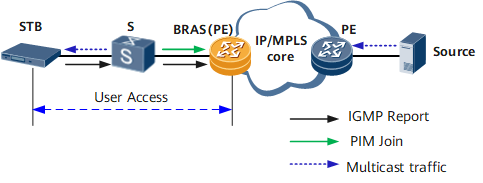User-side Multicast VPN
Service Overview
User-side multicast VPN enables a BRAS to identify users of a multicast program, which allows for improved management of them.
Networking Description
As shown in Figure 1, the STB user and the multicast source belong to the same VPN instance, which is a prerequisite for users to join programs of the multicast source on the VPN that they belong to. To join a multicast program after accessing the Layer 3 VPN, the STB user sends and IGMP Report message to the BRAS. Upon receipt of the IGMP Report message, the BRAS identifies the domain and private VPN instance of the STB user. Then the BRAS creates the multicast entry for the STB user in the corresponding VPN instance and sends the PIM Join message to the network-side multicast source or RP for the multicast traffic. As the final step, the BRAS replicates the multicast traffic to the STB user based on different multicast replication modes.
Feature Deployment
Deployment for the user-side multicast VPN is as follows:
Configure an IPv4 address pool on the BRAS to assign IPv4 addresses to online users.
Configure Authentication, Authorization and Accounting (AAA) schemes.
Configure a domain for user management, such as AAA.
Configure the PPPoE or IPoE access mode on the BRAS.
Configure basic multicast VPN functions.
- Configure a multicast replication mode on a BAS interface. By default, multicast replication by interface is configured. You can choose to configure one of the following multicast replication modes:
- Session-based multicast replication
- Multicast replication by interface + VLAN
- Multicast replication by VLAN
Bind a VPN instance of the specified multicast service to the main interface on a BRAS.
Enable IGMP and PIM on the main interface of the BRAS.
